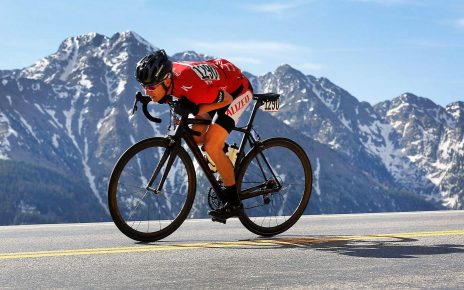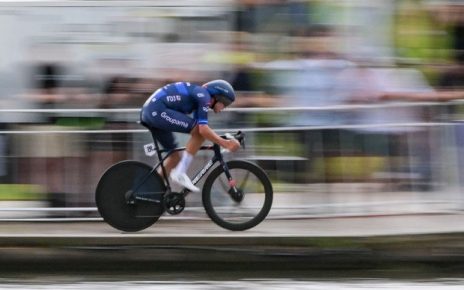
Luc ClaessenGetty Images
- Organizers have announced plans to host the “Battle of the North,” a 10-day women’s stage race, starting in 2021.
- The race aims to join the Women’s World Tour and cover three countries in Scandinavia.
- Along with the Giro Rosa, it would be the longest stage race on the elite women’s calendar.
Go north, young lady, for that’s where the top tier of women’s cycling will get a new stage race in 2021.
Billed as the “Battle of the North” for its Scandinavian setting, the event is expected to include 10 days of racing in Norway, Sweden, and Denmark. It will also combine three existing races: the four-day Ladies Tour of Norway, the one-day Vårgårda World Cup in Sweden, and the Danish stage race PostNord Danmark Rundt.
While shorter than the three-week Grand Tours in men’s cycling, the planned race’s organizers have wasted no time in dubbing it the “Tour de France for women.”
“Men’s racing has had Grand Tour stage races for many, many years,” said Roy Moberg, race director of the Ladies Tour of Norway and one of the officials behind the Battle of the North. “Except the Giro Rosa, women have nothing, and I think the teams and riders deserve high-quality races that can promote women’s cycling as something unique.”
Launching a large-scale stage race has long been a goal for the Ladies Tour organizers, Moberg said. Some of the top riders in women’s cycling, meanwhile, said the existing Scandinavian races are among the best on the calendar. Combining them could bring out the strengths of all three.
“I’ve done the Ladies Tour of Norway several times now, and it has beautiful stages and is very professional in organization,” said Marianne Vos, a three-time Road Worlds champion. Alexis Ryan, an American who won multiple national titles as a junior, called the Ladies Tour and Vårgårda two of her favorite races. “In general, Scandinavia is a wonderful place to race,” she said.
To put the race on the road, Moberg said organizers will need a budget of about 2 million euro, or $2.2 million. (Currently, the Ladies Tour and the Vårgårda World Cup run on a combined budget of 1.1 million euro, with the Norwegian government footing a significant part of the bill.) Moberg said he’s confident they can secure the additional funding through what he described as “some selected big, private sponsors.”
Organizers have also begun working with television broadcasters in the race’s three countries. To join the Women’s World Tour—the elite level of events for women’s cycling—races must meet criteria set out by the UCI, which starting in 2020 will include at least 45 minutes of live TV coverage. The hope is that more media coverage will attract increased sponsorship support for both teams and races.
“It’s like a chicken-and-egg discussion,” Moberg said. “If you don’t build a strong and attractive race that will be distributed on global media, you don’t succeed in bringing more money into the sport and you don’t succeed with the next step of development.”
Getting sponsorship for a new event is always a challenge, but the UCI rulebook could add a potential extra obstacle. Presently, UCI rules limit the length of Women’s World Tour stage races to five days, with the Giro Rosa being the only exception. (This year, the Italian race—the women’s answer to the Giro d’Italia—will run for 10 days in July.)
When contacted, however, the UCI sounded open to allowing the Battle of the North to run its full length. According to press officer Louis Chenaille, the UCI will evaluate all aspects of the race, including courses, logistics, technical organization, and media coverage.
“Based on this information, a decision will be made as to whether or not [permission] can be granted to this new stage race to be accepted on the UCI calendar, in the same way as for the Giro Rosa,” Chenaille said.
Though women riders have demanded a three-week Tour de France in the past, Vos said longer races aren’t a priority for her. Instead, she said she’d rather see “quality over quantity” and a balanced calendar of well-organized events with competitive fields and well-produced media coverage. Currently, Women’s World Tour events are notable for their dynamic, hard-charging racing.
“I don’t believe it’s necessary for women to race for three weeks straight,” Ryan agreed. “If you’ve ever raced your bike flat-out for 10 days straight, then you’d understand that it isn’t necessary to have longer races.”
The news of a fresh race on the Women’s World Tour comes as two high-profile events will leave the series next season. Flèche-Wallone and Liège-Bastogne-Liège, both one-day races, will drop to the second-tier Pro Series level. The reason: Their organizer, the ASO, said it won’t secure the required TV coverage due to budget concerns.
“Big players in cycling, like the ASO, don’t want to invest in women’s cycling,” Moberg said. “We do, because women deserve it.”




